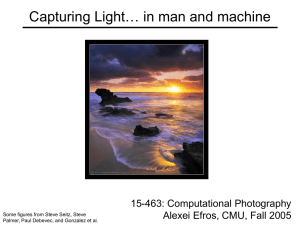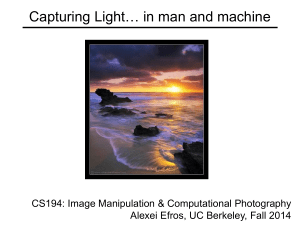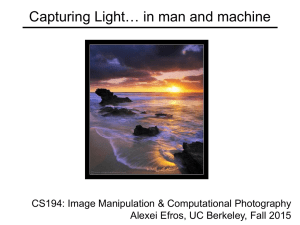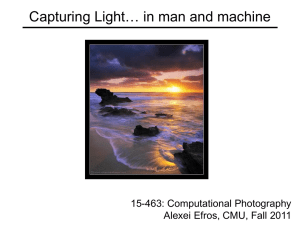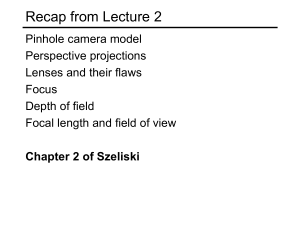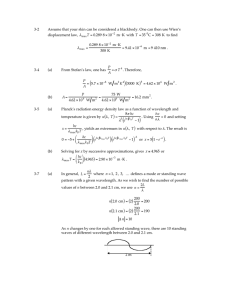Capturing Light… in man and machine 15-463: Computational Photography
advertisement
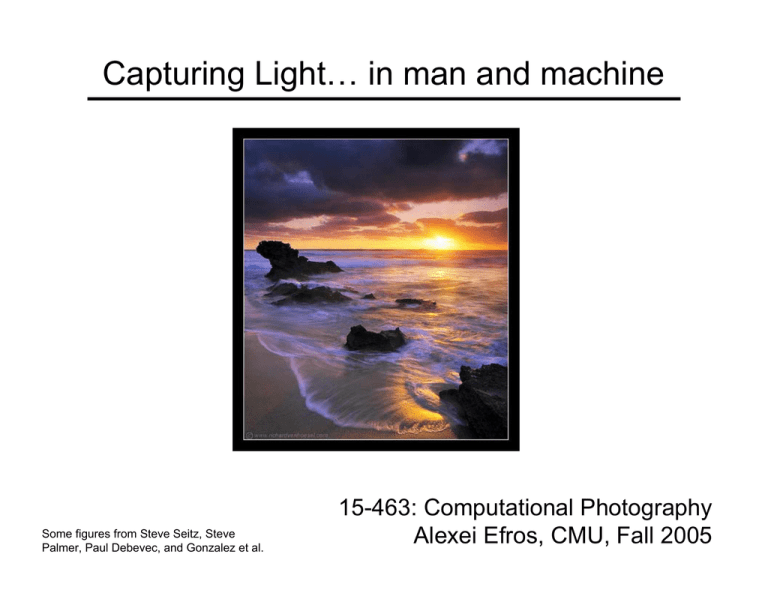
Capturing Light… in man and machine Some figures from Steve Seitz, Steve Palmer, Paul Debevec, and Gonzalez et al. 15-463: Computational Photography Alexei Efros, CMU, Fall 2005 Image Formation Digital Camera Film The Eye Digital camera A digital camera replaces film with a sensor array • • • Each cell in the array is light-sensitive diode that converts photons to electrons Two common types – Charge Coupled Device (CCD) – CMOS http://electronics.howstuffworks.com/digital-camera.htm Sensor Array CMOS sensor Sampling and Quantization Interlace vs. progressive scan http://www.axis.com/products/video/camera/progressive_scan.htm Progressive scan http://www.axis.com/products/video/camera/progressive_scan.htm Interlace http://www.axis.com/products/video/camera/progressive_scan.htm The Eye The human eye is a camera! • Iris - colored annulus with radial muscles • Pupil - the hole (aperture) whose size is controlled by the iris • What’s the “film”? – photoreceptor cells (rods and cones) in the retina The Retina Cross-section of eye Cross section of retina Pigmented epithelium Ganglion axons Ganglion cell layer Bipolar cell layer Receptor layer Retina up-close Light Two types of light-sensitive receptors Cones cone-shaped less sensitive operate in high light color vision Rods rod-shaped highly sensitive operate at night gray-scale vision cone rod © Stephen E. Palmer, 2002 Rod / Cone sensitivity The famous sock-matching problem… # Receptors/mm2 Distribution of Rods and Cones Fovea 150,000 Rods Blind Spot Rods 100,000 50,000 0 Cones Cones 80 60 40 20 0 20 40 60 80 Visual Angle (degrees from fovea) Night Sky: why are there more stars off-center? © Stephen E. Palmer, 2002 Electromagnetic Spectrum Human Luminance Sensitivity Function http://www.yorku.ca/eye/photopik.htm Visible Light Why do we see light of these wavelengths? 10000 C . Energy …because that’s where the Sun radiates EM energy 5000 C 2000 C 700 C 0 400 700 1000 Visible Region 2000 Wavelength (nm) 3000 © Stephen E. Palmer, 2002 The Physics of Light Any patch of light can be completely described physically by its spectrum: the number of photons (per time unit) at each wavelength 400 - 700 nm. # Photons (per ms.) 400 500 600 700 Wavelength (nm.) © Stephen E. Palmer, 2002 The Physics of Light Some examples of the spectra of light sources B. Gallium Phosphide Crystal # Photons # Photons A. Ruby Laser 400 500 600 400 500 700 Wavelength (nm.) 700 Wavelength (nm.) D. Normal Daylight # Photons C. Tungsten Lightbulb # Photons 600 400 500 600 700 400 500 600 700 © Stephen E. Palmer, 2002 The Physics of Light % Photons Reflected Some examples of the reflectance spectra of surfaces Red 400 Yellow 700 400 Blue 700 400 Wavelength (nm) Purple 700 400 700 © Stephen E. Palmer, 2002 The Psychophysical Correspondence There is no simple functional description for the perceived color of all lights under all viewing conditions, but …... A helpful constraint: Consider only physical spectra with normal distributions mean area # Photons 400 500 variance 600 700 Wavelength (nm.) © Stephen E. Palmer, 2002 The Psychophysical Correspondence # Photons Mean blue Hue green yellow Wavelength © Stephen E. Palmer, 2002 The Psychophysical Correspondence # Photons Variance Saturation hi. high med. medium low low Wavelength © Stephen E. Palmer, 2002 The Psychophysical Correspondence Area Brightness # Photons B. Area Lightness bright dark Wavelength © Stephen E. Palmer, 2002 Physiology of Color Vision Three kinds of cones: RELATIVE ABSORBANCE (%) 440 530 560 nm. 100 M S L 50 400 450 500 550 600 650 WAVELENGTH (nm.) • Why are M and L cones so close? • Are are there 3? © Stephen E. Palmer, 2002 More Spectra metamers Color Sensing in Camera (RGB) 3-chip vs. 1-chip: quality vs. cost Why more green? Why 3 colors? http://www.cooldic http://www.cooldi tionary.com/words/Bayer-filter.wikipedia Practical Color Sensing: Bayer Grid Estimate RGB at ‘G’ cels from neighboring values http://www.cooldictionary.com/ words/Bayer-filter.wikipedia RGB color space RGB cube • • • • Easy for devices But not perceptual Where do the grays live? Where is hue and saturation? HSV Hue, Saturation, Value (Intensity) • RGB cube on its vertex Decouples the three components (a bit) Use rgb2hsv() and hsv2rgb() in Matlab White Balance White World / Gray World assumptions Programming Assignment #1 • How to compare R,G,B channels? • No right answer • Sum of Squared Differences (SSD): • Normalized Correlation (NCC): Image Pyramids (preview) Known as a Gaussian Pyramid [Burt and Adelson, 1983] • In computer graphics, a mip map [Williams, 1983] • A precursor to wavelet transform Image Formation f(x,y) = reflectance(x,y) * illumination(x,y) Reflectance in [0,1], illumination in [0,inf] Problem: Dynamic Range The real world is High dynamic range 1 1500 25,000 400,000 2,000,000,000 Is Camera a photometer? Image pixel (312, 284) = 42 42 photos? Long Exposure 10-6 Real world High dynamic range 10-6 106 106 Picture 0 to 255 Short Exposure 10-6 Real world High dynamic range 10-6 106 106 Picture 0 to 255 Image Acquisition Pipeline Lens scene radiance Shutter sensor irradiance 2 (W/ sr/m2 ) (W/sr/m ∫ sensor sensor exposure Δt CCD ADC analog voltages Remapping digital values Camera is NOT a photometer! pixel values Varying Exposure What does the eye sees? The eye has a huge dynamic range Do we see a true radiance map? Eye is not a photometer! "Every light is a shade, compared to the higher lights, till you come to the sun; and every shade is a light, compared to the deeper shades, till you come to the night." — John Ruskin, 1879 Cornsweet Illusion Sine wave Campbell-Robson contrast sensitivity curve Metamers Eye is sensitive to changes (more on this later…)
